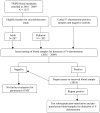Absence of transfusion-associated microchimerism in pediatric and adult recipients of leukoreduced and gamma-irradiated blood components
- PMID: 21981710
- PMCID: PMC3257351
- DOI: 10.1111/j.1537-2995.2011.03366.x
Absence of transfusion-associated microchimerism in pediatric and adult recipients of leukoreduced and gamma-irradiated blood components
Abstract
Background: Transfusion-associated microchimerism (TA-MC), the persistence of significant levels of donor white blood cells (WBCs) in blood recipients for prolonged periods, has been demonstrated after nonleukoreduced and leukoreduced transfusion to patients with severe traumatic injury. Development of TA-MC has not been rigorously studied in settings that do not involve massive trauma where the blood is leukoreduced and irradiated.
Study design and methods: A cohort of 409 prospectively followed medical and surgical adult and pediatric female recipients of leukoreduced and mostly irradiated allogeneic red blood cell and platelet transfusions were evaluated to determine development of TA-MC. Four- and 8-weeks-posttransfusion samples were analyzed using quantitative real-time polymerase chain reaction for Y-chromosome sequences in WBC DNA, the marker for microchimeric cells in female blood recipients. Repeat testing was performed on Y-chromosome-positive samples to confirm microchimerism (MC), and subsequent posttransfusion samples were tested to investigate persistence of MC.
Results: On initial testing, 40 of 207 (19%) adult and 44 of 202 (22%) pediatric female blood recipients demonstrated low-level MC. On repeat testing of these and additional specimens, 12 (3%) recipients demonstrated low-level transient MC, but none had persistent TA-MC similar to that seen in transfused trauma patients.
Conclusion: Persistence of MC was not demonstrated in adult and pediatric recipients of leukoreduced and mostly irradiated blood components. The risk of TA-MC appears to be dependent on the clinical setting and is rare other than in patients sustaining severe traumatic injury.
© 2011 American Association of Blood Banks.
Conflict of interest statement
Conflict of Interest: None
Figures
Comment in
-
The microchimerism puzzle.Transfusion. 2012 May;52(5):926-8. doi: 10.1111/j.1537-2995.2012.03645.x. Transfusion. 2012. PMID: 22571359 No abstract available.
Similar articles
-
Transfusion-associated microchimerism: the hybrid within.Transfus Med Rev. 2013 Jan;27(1):10-20. doi: 10.1016/j.tmrv.2012.08.002. Epub 2012 Oct 24. Transfus Med Rev. 2013. PMID: 23102759 Free PMC article. Review.
-
High-level long-term white blood cell microchimerism after transfusion of leukoreduced blood components to patients resuscitated after severe traumatic injury.Transfusion. 2005 Aug;45(8):1280-90. doi: 10.1111/j.1537-2995.2005.00201.x. Transfusion. 2005. PMID: 16078913
-
Leukoreduction of blood transfusions does not diminish transfusion-associated microchimerism in trauma patients.Transfusion. 2006 Nov;46(11):1863-9. doi: 10.1111/j.1537-2995.2006.00991.x. Transfusion. 2006. PMID: 17076839 Clinical Trial.
-
Survival of transfused donor white blood cells in HIV-infected recipients.Blood. 2001 Jul 15;98(2):272-9. doi: 10.1182/blood.v98.2.272. Blood. 2001. PMID: 11435293 Clinical Trial.
-
Transfusion-associated microchimerism: a new complication of blood transfusions in severely injured patients.Semin Hematol. 2007 Jan;44(1):24-31. doi: 10.1053/j.seminhematol.2006.09.012. Semin Hematol. 2007. PMID: 17198844 Review.
Cited by
-
Leucoreduction of blood components: an effective way to increase blood safety?Blood Transfus. 2016 May;14(2):214-27. doi: 10.2450/2015.0154-15. Epub 2015 Dec 16. Blood Transfus. 2016. PMID: 26710353 Free PMC article. Review.
-
Leukoreduction and ultraviolet treatment reduce both the magnitude and the duration of the HLA antibody response.Transfusion. 2014 Mar;54(3):672-80. doi: 10.1111/trf.12317. Epub 2013 Jun 30. Transfusion. 2014. PMID: 23808544 Free PMC article.
-
Microchimerism of male origin in a cohort of Danish girls.Chimerism. 2015 Oct 2;6(4):65-71. doi: 10.1080/19381956.2016.1218583. Epub 2016 Aug 11. Chimerism. 2015. PMID: 27623703 Free PMC article.
-
One size will never fit all: the future of research in pediatric transfusion medicine.Pediatr Res. 2014 Nov;76(5):425-31. doi: 10.1038/pr.2014.120. Epub 2014 Aug 13. Pediatr Res. 2014. PMID: 25119336 Free PMC article. Review.
-
Transfusion-associated microchimerism: the hybrid within.Transfus Med Rev. 2013 Jan;27(1):10-20. doi: 10.1016/j.tmrv.2012.08.002. Epub 2012 Oct 24. Transfus Med Rev. 2013. PMID: 23102759 Free PMC article. Review.
References
-
- Adams KM, Nelson JL. Microchimerism: an investigative frontier in autoimmunity and transplantation. JAMA. 2004;291:1127–31. - PubMed
-
- Lee TH, Paglieroni T, Ohto H, et al. Survival of donor leukocyte subpopulations in immunocompetent transfusion recipients: frequent long-term microchimerism in severe trauma patients. Blood. 1999;93:3127–39. - PubMed
-
- Lee TH, Paglieroni T, Utter GH, et al. High-level long-term white blood cell microchimerism after transfusion of leukoreduced blood components to patients resuscitated after severe traumatic injury. Transfusion. 2005;45:1280–90. - PubMed
Publication types
MeSH terms
Grants and funding
LinkOut - more resources
Full Text Sources


